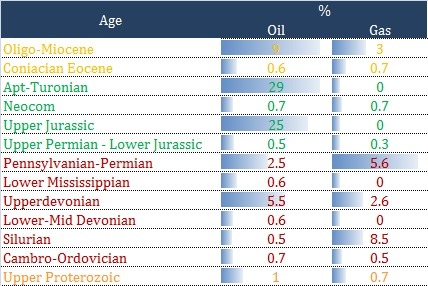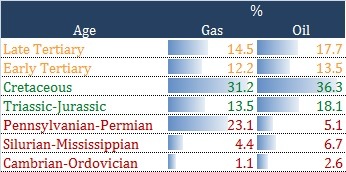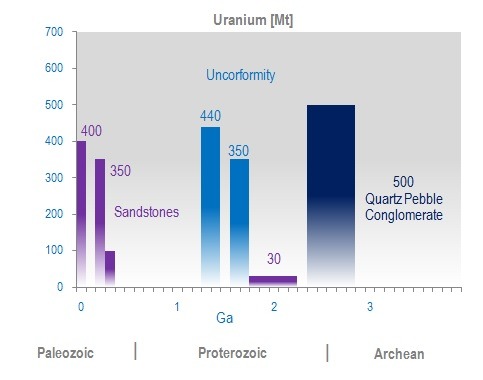10 Interesting Cases Of Natural Resources Distribution In Geological Time
Part 1 Energy Resources
In article “Classifications Of An Ore Deposits – Why There Are So Many?” I wrote some general information about time distribution of metals and hydrocarbon deposits. This issue is extremely interesting, because it allow us to take a deep look into Earth’s past.
With great respect to methodology of science I have to make a little introduction with two general thoughts.
Throughout geological history Earth’s crust was created and destroyed due to many different processes. Some parts of rocks had survived, some part did not. We will focus only on those mineral deposits, which occurred extremely abundantly throughout particular moments of geological time.
Some of mineral deposits were forming with varying intensity depending on fluctuations in geological and/or environmental factors. Other was shaped in specific moment of geological evolution when several specific conditions imposed. These processes in combination with plenty of erosional-depositional cycles resulted
in complicated picture of space and time distribution of ore and hydrocarbon deposits.
Secondly, according to biogenic theory hydrocarbons are generated in source rock – a fine-grained sediments mixed up with organic debris. Then, in depth and under the influence of high temperature, they mature and migrate to porous and permeable rocks like sandstones or limestones. In general, this type of hydrocarbons is defined as conventional deposits. Age of reservoir rocks and generated hydrocarbons withinare not the same.
However, enormous amount of hydrocarbons are defined as unconventional deposits. Source rocks like shales with trapped oil and gas belong to this type of deposits. Nowadaysthey are commercially exploited. Age of hydrocarbons in source rocks and age of these rocks are the same. Other examples of unconventionals are oil sands, methane hydrates or tight oil.
(P.S. We do not consider abiogenic petroleum origin. According to this theory, hydrocarbons are generated in Earth’s mantle all the time.)
Conclusions: trying to estimate when how much hydrocarbons or ore deposits were generated in each geological epoch, we are facing scattered data and an assumption bias. However uneven distribution of oil, gas, gold or iron in time is so significant, that we have to take a look at this interesting phenomenon.
1. OIL & 2. GAS
Generally origin of oil and gas has the same origin, so they are described together.
There are few synthetic descriptions on how much oil and gas was originated in geological time. The general conclusions are below.
According to Klemme and Ulmishek more than
- 90% of hydrocarbons reserves were generated from source rocks deposited during 6 stratigraphic intervals (Silurian, Upper Devonian, Pennsylvanian/Lower Permian, Upper Jurassic, middle part of Cretaceous and Oligo-Miocene),
- 70% of the source rocks were generated during marine transgression phases (increasing of global sea level).


based on H.D. Klemme; G.F. Ulmishek (1991)
Bois, Bouche and Pelet in contrast to previous authors compiled global reserves of oil and gas. In other words graph below shows amount of petroleum and natural gas in reservoir rocks – not source rocks, where hydrocarbons were generated. However all mentioned scientists claim that the accumulation phase took place mainly during the Mesozoic Era. Most of all hydrocarbon reserves are trapped in reservoir rocks of Jurassic and Cretaceous Era.


based on C. Bois; P. Bouche; R. Pelet (1982)
Occurring of hydrocarbons throughout geological time was a result of evolution and blooming of a biosphere and fluctuation of sea level. There is a positive correlation between increasing of global sea level and amount of hydrocarbons generated in rocks. Exuberance of organic debris in Mesozoic (in comparison to Paleozoic) obviously expanded potential for oil and gas formation.
Variability of the sea level and juxtaposed data from mentioned publications are imposed and presented on diagram below.

3. COAL
Coal was formed due to biodegradation and burial of huge number of trees from ancient forests. There a few types of coal classified according to its rank. Peat and lignite has the lowest rank and it is the most immature form of a coal. Bituminous (or a black) coal has a higher rank. Anthracite has the highest rank and it is the most mature and most caloric type of coal. Black coal and anthracite occur in Paleozoic and Mesozoic. Younger coal is called lignite.
Major coal peak was an effect of superimposed ecological, climatic and biogeochemial factors, which unique
one-time combination led to origin to enormous coal deposits.
In Triassic occurred “a coal gap” – its genesis is unclear and still debated.

Based on Bestougeff, 1980
4. URANIUM
According The International Atomic Energy Agency (IAEA) there are 15 main categories of uranium deposits:
- 1. Unconformity-related deposits
- 2. Sandstone deposits
- 3. Quartz-pebble conglomerate deposits (placers)
- 4. Breccia complex deposits
- 5. Vein deposits
- 6. Intrusive deposits (Alaskites) 7. Phosphorite deposits
- 8. Collapse breccia pipe deposits
- 9. Volcanic deposits
- 10. Surficial deposits
- 11. Metasomatite deposits
- 12. Metamorphic deposits
- 13. Lignite
- 14. Black shale deposits
- 15. Other types of deposits
The Greatest economically significance has unconformity type and sandstone types.
There are three major periods in which uranium deposits were formed.
(1) Quartz-pebble conglomerates called placers (or rather paleoplacers in this case) were deposited due to erosion of uranium-rich magmatic rocks. They are restricted to the Late Archaean and Early Proterozoic, when redox conditions helped to preserve these deposits. Examples are deposits within huge continental basins like Witwatersrand in South Africa or Bind River in Canada.
(2) Unconformity-related uranium deposits are related to strong increase of atmospheric oxygen. These deposits were formed mainly in Proterozoic. It was formed at the base of the unconformity between faulted and brecciated metasedimentary rocks and younger Proterozoic undeformed sandstones. Mineralization resulted due to hydrothermal fluids activity. Examples are gigantic Canadian deposits in Athabasca Basin. This type
of uranium deposits constitute about one-third of the western world’s uranium resources.
(3) Sandstone type was started to develop from Silurian during colonization of continents by plants. Organic debris has ability to trap uranium minerals effectively. Therefore significant amount of uranium deposits was deposited within continental clastic sediments where huge amounts of terrestrial organic material occurred.

Dodaj komentarz